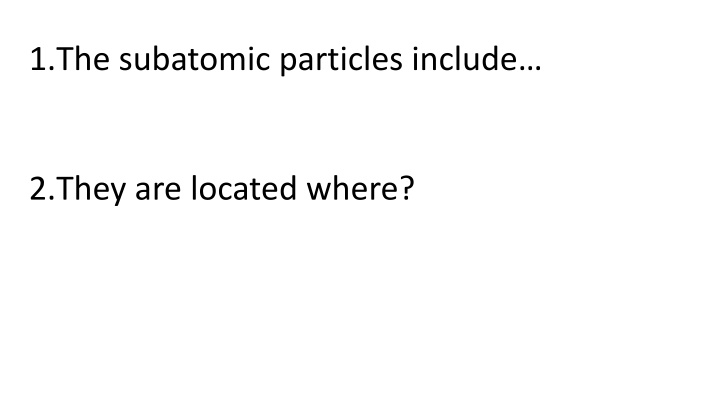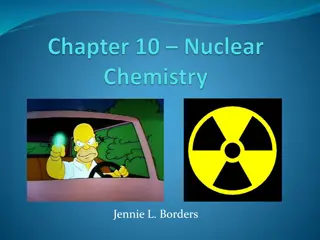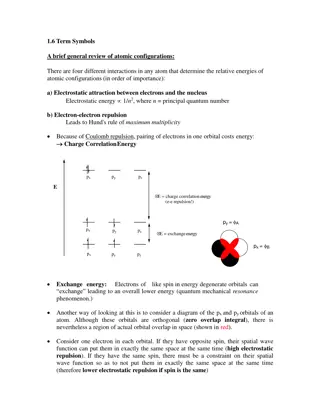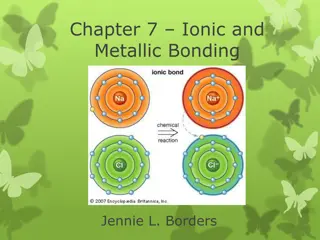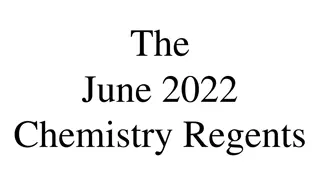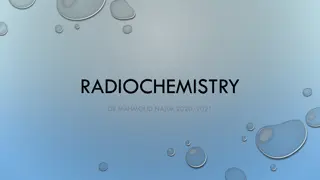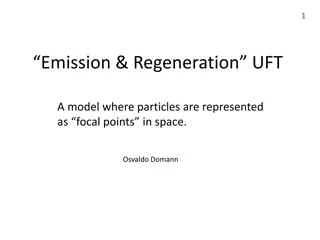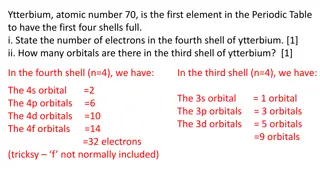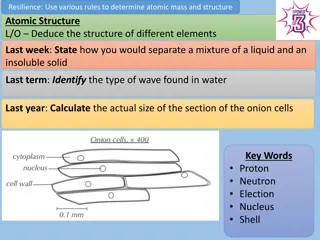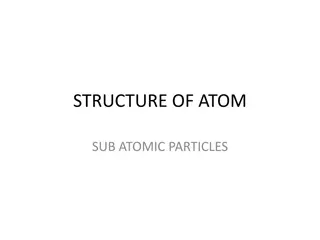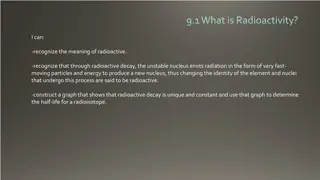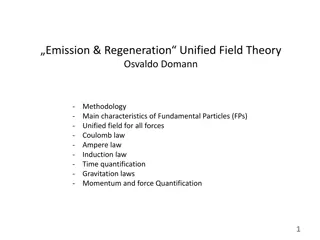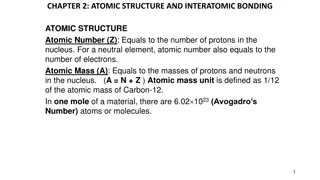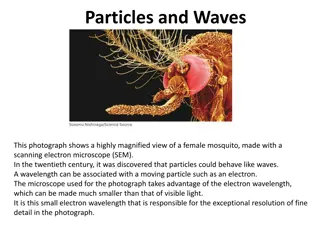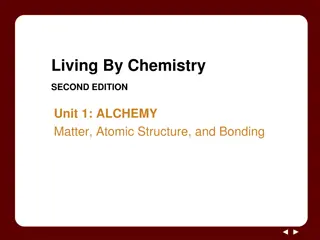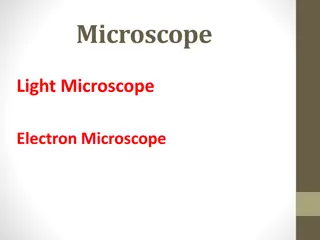Subatomic Particles and Electron Configurations
Exploring the subatomic particles - protons, neutrons, and electrons - and their location within an atom. Understand how charges and masses differ among these particles. Neils Bohr's contribution to electron excitation and emission of spectra. Questions answered about electron count in scandium, aluminum, chloride ions, iron atoms, and Fe cations.
Download Presentation

Please find below an Image/Link to download the presentation.
The content on the website is provided AS IS for your information and personal use only. It may not be sold, licensed, or shared on other websites without obtaining consent from the author.If you encounter any issues during the download, it is possible that the publisher has removed the file from their server.
You are allowed to download the files provided on this website for personal or commercial use, subject to the condition that they are used lawfully. All files are the property of their respective owners.
The content on the website is provided AS IS for your information and personal use only. It may not be sold, licensed, or shared on other websites without obtaining consent from the author.
E N D
Presentation Transcript
1.The subatomic particles include 2.They are located where?
1.The subatomic particles include Protons, neutrons and electrons. 2.They are located where? Protons and neutrons are in the nucleus, while the electrons fly around outside of the nucleus.
Their charges and masses are? The electrons live in zones called The electrons fill up the lowest energy levels, which is called the
Their charges and masses are? Protons mass = 1 AMU, charge is +1 Neutrons mass = 1 AMU, charge is zero or neutral Electrons have no mass (in High School) and have a -1 charge The electrons live in zones called orbitals The electrons fill up the lowest energy levels, which is called the ground state. All electron configurations on the reference table are in the ground state, the lowest possible energy state.
Neils Bohr described how electrons can become excited when they absorb unique amounts of energy. When these excited electrons return to the ground state, they emit
Neils Bohr described how electrons can become excited when they absorb unique amounts of energy. When these excited electrons return to the ground state, they emit Spectra, which we can see as color light, or with refractive lenses, we can break up that one color our eyes see into the unique colors at specific wavelengths that make the color we see with our eyes. That spectra graph can be measured, and each substance has a unique spectra graph.
How many electrons are in an atom of scandium? How many electrons are in the cation of Aluminum? How many electrons are in the anion chloride? How many protons are in an atom of iron? How many electrons are in the cations of Fe+2 and Fe +3?
How many electrons are in an atom of scandium? Sc has 21 e- How many electron are in the cation of Aluminum? Al has 13 electrons as an atom, but only 10 e- as a cation. How many electrons are in the anion of chlorine called chloride? Cl has 17 electrons, but as Cl-1, it has 18e-. How many protons are in an atom of iron? 26 p+ How many electrons are in the cations of Fe+2 and Fe +3? Atoms of iron has 26 e-, Fe+2 has 24 e-, Fe+3 has 23 e-
Put these particles in mass order, lowest mass to highest mass Proton, electron, neutron, alpha, positron, hydrogen cation, water molecule, hydrogen molecule, H-3 isotope, H-2 isotope, helium nucleus, beta particle, and methane molecule.
lowest mass to highest mass Electrons, positrons, & beta particles have 0 mass * Protons, neutrons & H+1 cations have mass of 1 AMU H2 molecule, H-2 isotope both have mass of 2 AMU H-3 isotopes have mass of 3 AMU Alpha particles & He nuclei have mass of 4 AMU CH4 has mass of 16 AMU H2O has mass of 18 AMU
For each atom state the proper values: Carbon: atomic number, atomic mass, number of electrons, number of protons, and number of neutrons. Magnesium: atomic number, atomic mass, number of electrons, number of protons, and number of neutrons.
For each atom state the proper values: Carbon: atomic number is 6, atomic mass is 12 AMU, it has 6 electrons, 6 protons, and 6 neutrons. Magnesium: atomic number is 12, atomic mass is 24 AMU, it has 12 electrons, 12 protons, and 12 neutrons too.
Which of these are Ionic, molecular, and is it an empirical formula? If not, what is the empirical formula? HOH(L) NaCl(S) CH4 C6H12O6 CH3CH2CH2CH3 HC2H3O2 NaOH SO2 N2O4 C8H18
Which of these are Ionic, molecular, and is it an empirical formula? If not, what is the empirical formula? HOH(L) molecular and empirical (it can t be reduced) NaCl(S) ionic and empirical (it can t be reduced) CH4 molecular and empirical (it can t be reduced) C6H12O6 molecular. The empirical formula would be CH2O CH3CH2CH2CH3 molecular and empirical. The empirical formula would be C2H5 HC2H3O2 molecular and empirical (it can t be reduced) NaOH ionic and empirical (it can t be reduced) SO2 molecular and empirical (it can t be reduced) N2O4 molecular. The empirical formula would be NO2 C8H18 molecular. The empirical formula would be C4H9
In all chemical reactions, what is conserved? Choose all that apply charge, density, number of moles, mass, number of ions, vapor pressure, temperature, energy, first ionization energy, atomic radius, number of particles
In all chemical reactions, what is conserved? Choose all that apply charge, mass, and energy
Fission Acid base neutralization Name the types of reactions shown here Artificial transmutation Addition CO2 C + O2 Natural transmutation Substitution Radioactive decay 2Na + 2HCl 2NaCl + H2 Single replacement Combination Combustion HCl + KOH KCl + HOH Fermentation Double replacement AB(AQ) + CD(AQ) AD(AQ) + CB(S) Synthesis Decomposition Esterification Fusion CH4 + 2O2 CO2 + H2O + energy Polymerization 2H2 + O2 2HOH
Name the types of reactions shown here CO2 C + O2 Decomposition 2Na + 2HCl 2NaCl + H2 Single replacement HCl + KOH KCl + HOH Acid base neutralization AB(AQ) + CD(AQ) AD(AQ) + CB(S) Double replacement CH4 + 2O2 CO2 + H2O + energy Combustion 2H2 + O2 2HOH Synthesis
Name the types of reactions shown here Acid base neutralization Addition Fission 4H+1 He + 2 positrons + energy Substitution Artificial transmutation CH4 + Br2 CH3Br + HBr Single replacement Natural transmutation C6H12O6 C2H5OH + CO2 Combustion Radioactive decay C2H5OH + CH3COOH HOH + CH3CH2COOCH3 Double replacement Combination C2H2 + F2 C2H2F2 Decomposition Esterfication Fermentation C-14 beta + N-14 Synthesis U-235 + n Kr-85 + Ba-141+ 3n + energy Polymerization Fusion n(C2H3F) ( ~CH2CHF~)n
Name the types of reactions shown here 4H+1 He + 2 positrons + energy Fusion CH4 + Br2 CH3Br + HBr Substitution C6H12O6 C2H5OH + CO2 Fermentation C2H5OH + CH3COOH HOH + CH3CH2COOCH3 Esterification C2H2 + F2 C2H2F2 Addition C-14 beta + N-14 Natural transmutation U-235 + n Kr-85 + Ba-141+ 3n + energy Artificial transmutation n(C2H3F) ( ~CH2CHF~)n Polymerization
How many electrons are shared by the carbon atoms in C2H4 C2H6 C2H2 How many pairs of electrons are shared by the atoms of these molecules? O2 CO HF N2
How many electrons are shared by the carbon atoms in C2H4 four electrons in one double nonpolar covalent bond C2H6 two electrons in one single nonpolar covalent bond C2H2 six electrons in one triple nonpolar covalent bond How many pairs of atoms are shared by the atoms of these molecules? O2 2 pairs of electrons in one double nonpolar covalent bond CO 2 pairs in a double polar covalent bond PLUS oxygen lends 2 electrons to the middle to make a coordinate covalent bond as well. HF 1 pair of electrons in a single polar covalent bond N2 3 pairs in a triple nonpolar covalent bond
Name all of the bonds in each molecule O2 CO2 (there are identical bonds on both sides) O3 HCl NaCl N2 H2C2 (two kinds, H-C and C-C bonds) Br2 MgO AlP
Name all of the bonds in each molecule O2 double nonpolar covalent bond CO2 (there are identical bonds on both sides) both are double polar covalent bonds O3 ozone has resonating bonds that are sorta double and sorta single, but they are both unstable, so they flip back and forth many times per second, resulting in stable enough to hold together HCl single polar covalent NaCl ionic N2 triple nonpolar covalent H2C2 H-C are single polar covalent, the C-C bond is a triple nonpolar covalent bond Br2 single nonpolar covalent MgO ionic AlP ionic
Put each pair in size order, smaller to larger Rb atom and I atom Rb atoms and Rb+1 cations I atoms and I-1 anions C-12 and C-14 Na+1 and Cl-1 Co atoms and Ni atoms Kr and Ar H atom and He atom
Put each pair in size order, smaller to larger I atom < Rb atom check Table S Rb+1 cations < Rb atoms The cation has lost a whole orbital I atoms < I-1 anions The anion has 1 extra electron, which stretches out that valence orbital C-12 = C-14 these isotopes have different numbers of neutrons (no difference in radius) Na+1 < Cl-1 sodium ion has 2 orbitals vs. 3 orbitals for chloride Ni atoms < Co atoms An exception to the period trend, check atomic radius Table S Ar < Kr argon has 3 orbitals to krypton s four orbitals H atom < He atom another period trend exception, check atomic radius Table S
The units required to measure these are You can use these units once, or more than once. Time Mass/volume Pressure Joule Second Mass Gram Kelvin Energy Centimeter PPM Concentration Kilogram Atm Atomic mass Kilojoule Centigrade Length AMU Picometers Temperature kPa H Density Molarity Atomic radius Vapor pressure Meter
The units required to measure these are Time second Pressure kPa Mass grams, kilogram Energy Joule, kilojoule Concentration molarity, PPM Atomic mass AMU Length centimeter, meter, picometers Temperature Kelvin, Centigrade, Celsius Density mass/volume Vapor pressure kPa
Concerning dynamic equilibriums, what is important to say?
Concerning dynamic equilibriums, what is important to say? The rate of the forward reaction is equal to the rate of the reverse reaction.
When it comes to gas pressure, volume and temperature, state the relationships between them Pressure and Temperature are Volume and Temperature are Volume and Pressure are
When it comes to gas pressure, volume and temperature, state the relationships between them Pressure and Temperature are directly proportional Volume and Temperature are directly proportional Volume and Pressure are inversely proportional
The difference between the potential energy of the reactants and the potential energy of the products is called The amount of energy required to start a chemical reaction is called... A catalysts can do 2 things, they are What 3 things increase the rate of reaction? What is the formula to calculate rate?
The difference between the potential energy of the reactants and the potential energy of the products is called heat of reaction or H. The amount of energy required to start a chemical reaction is called... The activation energy A catalysts can do 2 things, they are lower activation energy, or offer an alternate pathway for the reaction to occur quicker What 3 things increase the rate of reaction? More surface area, increased concentration of reactants, increase temperature, all of which increase the numbers of collisions between particles. What is the formula to calculate rate? Rate = 1/time in seconds
Whats the difference between heat of reaction and heat of solution? What ONE symbol can be used for both? Does that ever get a sign (positive or negative?)
Whats the difference between heat of reaction and heat of solution? Both are the difference in potential energy between the start and end of a reaction, and both can be positive or negative (endo or exothermic), but heat of solution is when a solid compound dissolves into water, which is a mixture, NOT A CHEMICAL REACTION. What ONE symbol can be used for both? H Does that ever get a sign (positive or negative?) It always gets a sign or else you lose a point because you re showing that you don t know if it s exothermic (- H), or if it s endothermic (+ H).
Name these C2H6 CH3CH2CH2NH2 CH3CHNH2CH3 CH3CH2OCH3 CH3(CH2) 4COOH CH3CH2COOCH2CH2CH3 CH3CH2CH2COOCH2CH3 CH3COOH CH3CH2CH2CH2CH2CHO C7H14
Name these C2H6 ethane CH3CH2CH2NH2 1propanamine CH3CHNH2CH3 2propanamine CH3CH2OCH3 ethyl methyl ether CH3(CH2) 4COOH hexanoic acid (6 total carbon atoms) CH3CH2COOCH2CH2CH3 ethyl propanoate (ester group is COO, name the oxygen tail side first) CH3CH2CH2COOCH2CH3 ethyl butanoate (2 carbons on the tail side, four more on the other side) CH3COOH ethanoic acid (2 carbon organic acid, AKA acetic acid with the HC2H3O2 formula) CH3CH2CH2CH2CH2CHO hexanal (6 carbons, double bonded oxygen ON THE END) C7H14 a type of heptene (seven carbons, with the alkene general formula, on double bonded C=C)
Draw and name an isomer for CH3CH2OCH2CH3 Ethers and alcohols are quick and easy isomers. Any alcohol with four carbons is good. We can do a 1butanol or a 2butanol. They are both isomers of the diethyl ether up top, and also of each other. 1-butanol at left, the alcohol group is attached to the number 1 carbon. The blue molecule is 2-butanol, where the OH group is attached to the number 2 carbon. Note, the OH group is the same as an O H group.
Ethanoic acid and propanol can react to form. Acid + alcohol ester + water This is esterification. The water comes out weird . Normally you might think the acid would provide the H and the alcohol group would become the OH part of water. It s the opposite. The acid provides the OH and the alcohol provides just an H to make the water. This is sometimes called dehydration synthesis as water is removed in the production of the ester. We don t call it that in high school.
During oxidation and reduction, there is a transfer of. During Redox, what is conserved? A voltaic cell is said to An electrolytic cell is said to
During oxidation and reduction, there is a transfer of. Electrons, which is perfect. The same number of electrons that is oxidized is reduced as well. During Redox, what is conserved? Electrical charge A voltaic cell is said to use chemistry to make electricity An electrolytic cell is said to use electricity to force redox chemistry
Fission Which matches to which? Some answers use more than once, some not at all. Saponification Non spontaneous redox Esterfication Spontaneous redox Fermentation Combining a halogen to an unsaturated hydrocarbon Addition Switching in one halogen atom in a saturated hydrocarbon Substitution Electroplating Voltaic Cells Batteries Fusion Reacting acids and alcohols Fermentation Making ethanol alcohol Electrolytic Cells Making soap Combustion Splitting of larger nuclei into smaller ones Polymerization
Which matches to which? Some answers use more than once, some not at all. Non spontaneous redox Electricity makes chemistry Spontaneous redox Chemistry makes electricity Combining a halogen to an unsaturated hydrocarbon Addition Switching in one halogen atom in a saturated hydrocarbon Substitution Electroplating Electricity makes chemistry Batteries Chemistry makes electricity Reacting acids and alcohols Esterification Making ethanol alcohol Fermentation Making soap Saponification Splitting of larger nuclei into smaller ones Fission
Which are bases, which are acids, which is an alternate theory Base, which is an alternate theory Acid, which are neutral? Use some answers once, some more than once. Arrhenius Acid HCl(AQ) C6H12O6(AQ) HC2H3O2(AQ) Arrhenius Base HBr(AQ) H2SO4(AQ) C2H3OH(L) Alternate Acid NH3(AQ) Mg(OH)2(AQ) CH4(G) Alternate Base NH4+1(AQ) KNO3(AQ) H2CO3(AQ) Neutral NaCl(AQ) KOH(AQ) Unknown HOH(L) CH3COOH(AQ) C6H14(G) CH3CH2OH(AQ)
HCl(AQ) Arrhenius Acid Mg(OH)2(AQ) Arrhenius Base HBr(AQ) Arrhenius Acid KNO3(AQ) Neutral NH3(AQ) Alternate Base KOH(AQ) Arrhenius Base NH4+1 Neutral CH3COOH(AQ) Arrhenius Acid NaCl(AQ) Neutral CH3CH2OH Neutral HOH(L) Alternate Acid or Neutral! HC2H3O2(AQ) Arrhenius Acid C2H3OH(L) Neutral C6H14(G) Neutral CH4(G) Neutral C6H12O6(AQ) Neutral H2CO3(AQ) Arrhenius Acid H2SO4(AQ) Arrhenius Acid
1. Al 2-8 Looking at each species, determine if it s an atom in the ground state, an atom in the excited state, a cation or an anion. If it s an ion, state the charge of that ion. 2. B 2-2-1 3. P 2-8-8 4. Zr 2-8-18-10-1-1 5. Ne 2-7-1 6. Fe 2-8-14 7. Mg 2-7-3 8. N 2-8 9. Ar 2-7-8-1 10. K 2-8-8-1
1. Al 2-8 Al atoms have 13 electrons, this is the Al+3 cation 2. B 2-2-1 Boron has 5 electrons in a 2-3 configuration, this is an excited atom 3. P 2-8-8 Arsenic has 33 electrons as an atom, this is the As-3 anion 4. Zr 2-8-18-10-1-1 Zr atoms do have 40 electrons, but this one is excited 5. Ne 2-7-1 Neon is excited, still has 10e-1 6. Fe 2-8-14 Iron has 26 electrons, this is the Fe+2 cation 7. Mg 2-7-3 Mg atoms do have 12 electrons, this one is excited 8. N 2-8 Nitrogen atoms are 2-5, this one is the N-3 anion 9. Ar 2-7-8-1 Argon atoms have this many electrons, but this one is excited 10. K 2-8-8-1 This is potassium in the ground state
